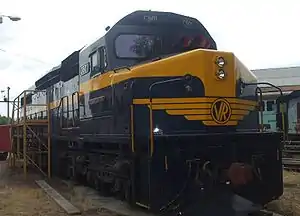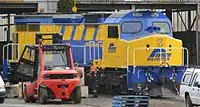| Victorian Railways C class | |||||||||||||||||||||||||||||||||||||||
|---|---|---|---|---|---|---|---|---|---|---|---|---|---|---|---|---|---|---|---|---|---|---|---|---|---|---|---|---|---|---|---|---|---|---|---|---|---|---|---|
 C501 at the Seymour Railway Heritage Centre in December 2007 | |||||||||||||||||||||||||||||||||||||||
| |||||||||||||||||||||||||||||||||||||||
| |||||||||||||||||||||||||||||||||||||||
| |||||||||||||||||||||||||||||||||||||||
| |||||||||||||||||||||||||||||||||||||||
The C Class are a class of diesel locomotive built by Clyde Engineering, Rosewater for the Victorian Railways in 1977–1978.
History
The C class were purchased by the Victorian Railways for heavy freight haulage. They are a variant of the WAGR L class (itself an Australianised EMD SD40) fitted with safety cabs. Initially, the first four were placed on the North East line to haul services from Melbourne to Albury while the latter six were put on the broad gauge to haul services on the Serviceton line. Following upgrades to the infrastructure, they were also able to operate on the Ballarat to Geelong line and from January 1982 through to Adelaide with the standard gauge units transferred to the broad gauge.[1]
On 3 August 1979, engines C505 and 506 ran through to Adelaide for the first time as part of a trial of through-running, in place of the previous practice involving changing locomotives at the border. C505 led on the westbound trip with a trailing load of 1,755 tonnes and 506 led on the eastbound with 1,804 tonnes. A number of stop-and-start tests were undertaken on the Adelaide hills line to test the engines' ability to handle heavy loads, and running times were tested particularly between Tailem Bend and Mile End. New radio communication systems were also trialled between the driver and guard using fixed units in lieu of the earlier portable units. The trial was deemed a success, with through-running becoming a regular feature from 12 November. At the time a number of C Class engines were running on the standard gauge between Melbourne and Albury, and it was intended to recall these for broad gauge interstate work and have them replaced by locomotives from Australian National Railways.[2]
In September 1988, two were transferred back to the standard gauge and began to operate services through to Sydney.[3][4]
Following the Melbourne-Adelaide railway being closed for gauge conversion, all remaining broad gauge units were converted to standard gauge and operated services from Melbourne to Parkes until the converted line reopened in July 1995. All were transferred by V/Line to National Rail in June 1995.[5]
Following the delivery of National Rail's NR class locomotives, the C class were put into storage at Junee Locomotive Depot in 1997 before being moved to Islington Railway Workshops, Adelaide.[6][7] Unlike the other locomotives National Rail initially used, ownership of the C class passed to National Rail.[8] In August 1999 two were repainted in National Rail livery and returned to service as Melbourne shunters.[9]
The class was then sold with one going to Seymour Railway Heritage Centre and the other nine to Allco Rail with two leased to Pacific National and seven to Silverton Rail as the Cs class.[5] Following the collapse of Allco Finance three were sold to Chicago Freight Car Leasing Australia and six to Greentrains in January 2008 with all resuming their original identities.[10][11][12]
In April 2016, the six Greentrains units were sold to Southern Shorthaul Railroad.[13][14] Having been in store at South Dynon Locomotive Depot, all were taken to the Lithgow State Mine Heritage Park & Railway with the last returned to service in August 2016.[15] As of July 2021, all 10 class members are operational.
Class list
| Locomotive | Name | Entered service | Owner | Operator | Livery | Status |
| C501 | George Brown | 14 May 1977 | Seymour Railway Heritage Centre | VR Blue & gold | Operational | |
| C502 | 22 June 1977 | Rail First Asset Management | Watco Australia | Rail First blue & yellow | Operational | |
| C503 | 19 July 1977 | Rail First Asset Management | Watco Australia | Rail First blue and yellow | Operational | |
| C504 | 18 August 1977 | Southern Shorthaul Railroad | Blue & yellow (SSR logos) | Operational | ||
| C505 | 13 September 1977 | Southern Shorthaul Railroad | Blue & yellow (SSR logos) | Operational | ||
| C506 | 6 October 1977 | Southern Shorthaul Railroad | Greentrains green & yellow (SSR logos) | Operational | ||
| C507 | 4 November 1977 | Southern Shorthaul Railroad | Blue & yellow (SSR logos) | Operational | ||
| C508 | 16 December 1977 | Rail First Asset Management | Watco Australia | Rail First blue & yellow | Operational | |
| C509 | 10 March 1978 | Southern Shorthaul Railroad | Greentrains green & yellow (SSR logos) | Operational | ||
| C510 | 11 July 1978 | Southern Shorthaul Railroad | Greentrains green & yellow (SSR logos) | Operational |
Gallery
 Silverton Rail Cs1 in July 1998
Silverton Rail Cs1 in July 1998 Southern Shorthaul Railroad C503 on Kooragang Island in January 2011
Southern Shorthaul Railroad C503 on Kooragang Island in January 2011 Southern Shorthaul Railroad C510 and C504 at Donnybrook
Southern Shorthaul Railroad C510 and C504 at Donnybrook Southern Shorthaul Railroad C505 at North Geelong Grain Loop
Southern Shorthaul Railroad C505 at North Geelong Grain Loop Southern Shorthaul Railroad C504-442s1-C510 Somerton
Southern Shorthaul Railroad C504-442s1-C510 Somerton Southern Shorthaul Railroad C504 - 4911 - RL302 on a loaded SSR Grain train to Geelong at Craigieburn
Southern Shorthaul Railroad C504 - 4911 - RL302 on a loaded SSR Grain train to Geelong at Craigieburn Victorian Railways Preserved C Class leader C501 in between Seymour Railway Heritage Centre's Victorian Railways T class (T357) and Southern Shorthaul Railroad's New South Wales 49 class locomotive (4917) at Albury
Victorian Railways Preserved C Class leader C501 in between Seymour Railway Heritage Centre's Victorian Railways T class (T357) and Southern Shorthaul Railroad's New South Wales 49 class locomotive (4917) at Albury
References
- ↑ Oberg, Leon (1984). Locomotives of Australia 1850s - 1980s. Frenchs Forest: Reed Books. p. 288. ISBN 0-730100-05-7.
- ↑ Network, Railways of Australia, October 1979, Vol.16 No.8 pp. 13–14
- ↑ "C Class" Railway Digest October 1988 page 378
- ↑ "C Class" Railway Digest November 1988 page 406
- 1 2 C Class diesel electric locomotives Archived 4 December 2007 at the Wayback Machine Mark Bau's VR website
- ↑ Antony Fitzgerald (April 2000). "The Dash 9 in Australia: National Rail's NR class". Australian Model Railway Magazine. p. 27.
- ↑ Railway Digest October 1998 page 41
- ↑ "One Nation - A retrospective and perspective" Railway Digest August 1997 page 21
- ↑ Railway Digest October 1999 page 4
- ↑ C Class (C501 - C510) Archived 31 January 2014 at the Wayback Machine Railpage
- ↑ C Class Archived 19 June 2004 at the Wayback Machine Vicsig
- ↑ "The 80 Class in Private Operation" Motive Power issue 80 March 2012 page 33
- ↑ Disposal of Greentrains rollingstock Archived 18 February 2017 at the Wayback Machine Engenco 28 April 2016
- ↑ "Greentrans rollingstock sold to Holdco Holdings" Railway Digest June 2016 page 6
- ↑ "SSR Report" Motive Power issue 107 September 2016 page 27
External links
![]() Media related to Victorian Railways C class diesel locomotives at Wikimedia Commons
Media related to Victorian Railways C class diesel locomotives at Wikimedia Commons